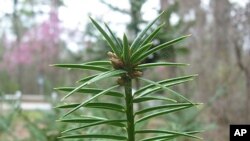Over 1 billion people worldwide depend on forests to sustain their livelihood, and billions more depend on forests to provide them with clean air and water.
In addition, it has been noted that forests are home to an estimated 80 percent of a diversity of plants and animals. But over the years many forests have been subject to destruction and degradation. However, some scientists are devoting their lives to conserving and rebuilding these precious life sources.
Terry Sunderland is one such scientist. He is a senior researcher with the Center for International Forestry Research, CIFOR, based in Bogor, Indonesia. He has spent many years in central Africa, and is an expert on the continent’s dry forests, biodiversity and food security.
He said one of the challenges of forest conservation in the past has been either just focusing on forest conservation. or just concentrating on protecting the livelihoods of those who depend on forests.
“One thing we are doing at CIFOR is looking at conservation and development and people’s livelihoods as a single thing, if you like, and integrating conservation on a landscape scale,” explained Sunderland.
He said a big challenge to the integration process is that it involves multiple scales of involvement.
“It’s all very well in approaching local people, and talking to them about how they conserve and manage their environment. Then you have the government over-lapping claims on a particular landscape, and we have regional claims on a particular landscape, and you have multi-national claims on a particular landscape. It’s like peeling back an onion,” said Sunderland.
Sunderland, who spent many years in central Africa, said he found that small-scale farmers in Africa do take measures to protect their land from degradation.
“Small-scale farmers do tend to practice what we consider very low impact agriculture. It is the larger expansion of agriculture crops, in particular palm oil, biofuel, which are the main contributors to deforestation and land degradation,” said Sunderland, who added people become more vested in their land if they have tenure. “Tenure is the fundamental contributor to what people do on the land. If you have access rights, the long term result is you will invest in protecting it. If you don’t, then people would tend to invest in more destructive practices.”
Sunderland said biodiversity contributes to food security on many levels.
“We are now dependent on only 20 crops for our food security. At any one time, it is estimated that over 2,000 crop species contribute towards human food security, and 95 percent of food consumed is based on only 20 of those. A few of those--rice, wheat, and maize--contribute to more than 50 percent of global food consumption,” explained Sunderland.
By narrowing our genetic base in terms of food, said Sunderland, we are exposing ourselves to enormous risks, particularly with climate change. He said widening our bio-resources not only provides nutritional benefits to humans but also provides more resilience to the dramatic effects of climate change.
In addition, it has been noted that forests are home to an estimated 80 percent of a diversity of plants and animals. But over the years many forests have been subject to destruction and degradation. However, some scientists are devoting their lives to conserving and rebuilding these precious life sources.
Terry Sunderland is one such scientist. He is a senior researcher with the Center for International Forestry Research, CIFOR, based in Bogor, Indonesia. He has spent many years in central Africa, and is an expert on the continent’s dry forests, biodiversity and food security.
He said one of the challenges of forest conservation in the past has been either just focusing on forest conservation. or just concentrating on protecting the livelihoods of those who depend on forests.
“One thing we are doing at CIFOR is looking at conservation and development and people’s livelihoods as a single thing, if you like, and integrating conservation on a landscape scale,” explained Sunderland.
He said a big challenge to the integration process is that it involves multiple scales of involvement.
“It’s all very well in approaching local people, and talking to them about how they conserve and manage their environment. Then you have the government over-lapping claims on a particular landscape, and we have regional claims on a particular landscape, and you have multi-national claims on a particular landscape. It’s like peeling back an onion,” said Sunderland.
Sunderland, who spent many years in central Africa, said he found that small-scale farmers in Africa do take measures to protect their land from degradation.
“Small-scale farmers do tend to practice what we consider very low impact agriculture. It is the larger expansion of agriculture crops, in particular palm oil, biofuel, which are the main contributors to deforestation and land degradation,” said Sunderland, who added people become more vested in their land if they have tenure. “Tenure is the fundamental contributor to what people do on the land. If you have access rights, the long term result is you will invest in protecting it. If you don’t, then people would tend to invest in more destructive practices.”
Sunderland said biodiversity contributes to food security on many levels.
“We are now dependent on only 20 crops for our food security. At any one time, it is estimated that over 2,000 crop species contribute towards human food security, and 95 percent of food consumed is based on only 20 of those. A few of those--rice, wheat, and maize--contribute to more than 50 percent of global food consumption,” explained Sunderland.
By narrowing our genetic base in terms of food, said Sunderland, we are exposing ourselves to enormous risks, particularly with climate change. He said widening our bio-resources not only provides nutritional benefits to humans but also provides more resilience to the dramatic effects of climate change.









